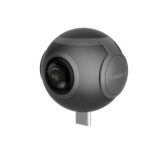Outdoor environments offer rich colors, changing light, and natural movement, making them ideal for panoramic and immersive recordings. Many creators, travelers, and hobbyists use tools like 360 Grad Kamera technology to capture the full atmosphere around them. Recording outdoors, however, brings unique challenges that can affect both the quality of the footage and the overall viewer experience. Preparing for these factors helps ensure the final result feels smooth, engaging, and true to the real scene.
Understanding Natural Lighting Conditions
Lighting is one of the biggest influences on panoramic footage. Outdoor light changes throughout the day, and because spherical cameras capture every angle, lighting issues can appear more clearly than in traditional video.
Direct sunlight can create harsh brightness on one side and shadows on the other. Early morning and late afternoon often provide softer light that blends more naturally across the full sphere. Cloudy days can also work well, as clouds diffuse light evenly. When filming near water or reflective surfaces, creators must watch for glare, which can disrupt the viewing experience and make some areas appear washed out.
Planning filming times around natural lighting helps maintain consistency and reduces the need for heavy editing.
Considering Wind and Environmental Sound
Outdoor sound adds life to a scene, but it can cause problems when it becomes too strong. Wind is a common issue, especially for panoramic footage where microphones record in all directions. Even a slight breeze can overpower the natural ambiance.
Creators often check wind levels before filming and choose more sheltered areas when possible. Trees, rock formations, and buildings can help soften gusts. Some people also use simple wind protection covers for microphones, which significantly reduce noise without affecting the device’s mobility.
Environmental sounds like nearby traffic, animals, or moving water may add depth, but it is important to know how they will affect the final recording.
Positioning the Camera for Best Coverage
Outdoor spaces offer many interesting angles, but panoramic cameras record everything, including the ground and sky. The camera’s position influences how balanced the scene appears.
Placing the device too low may cause the ground to dominate the lower half of the frame. Setting it too high may make the scene feel distant. A mid-level height often creates the most natural perspective. Recording on a stable surface is equally important, as outdoor terrain can be uneven, making the footage wobble if the stand is not secure.
Creators shooting while walking or moving should test how the camera handles motion in open spaces and adjust their pace to keep the scene comfortable for viewers.
Managing Weather Conditions
Weather adds personality to an outdoor scene, but it can also bring unpredictable challenges. Rain, humidity, and sudden temperature changes may affect both visibility and device performance.
Before filming, it helps to check weather forecasts and consider how the environment might change. Fog can create a moody atmosphere but may reduce clarity. Light rain can add texture to the scene, but heavy rain might obscure the lens. Extreme heat or cold can impact battery life and stability.
Creators who film regularly outdoors sometimes carry small cleaning cloths to wipe dust, droplets, or fingerprints from the lens.
Understanding the Environment’s Activity Level
Outdoor locations vary greatly. Some are quiet and open, while others are crowded and full of movement. Busy areas such as markets, parks, or streets add energy to a clip but can overwhelm viewers if too much happens at once. Calm environments like forests or beaches provide a more relaxed viewing experience.
Before filming, creators often take a moment to observe how the scene behaves. Are people moving quickly? Are animals present? Is traffic constant? Understanding the natural flow of the location helps determine the best moments to record.
Considering How Viewers Will Explore the Space
Panoramic footage is interactive. Viewers can turn the scene, zoom, and examine details that interest them. Because of this, the creator must think beyond the main subject. Everything in the surroundings contributes to the experience.
If filming a viewpoint, a balanced scene with visual interest in all directions works well. If recording an action moment, such as biking or hiking, creators consider what viewers may want to follow—movement behind them, scenery beside them, or activity ahead.
Thinking like a viewer helps build footage that feels intentional rather than chaotic.
Preparing for Physical Movement and Stability
Movement can make outdoor panoramic footage lively and immersive, but it also increases the chance of shaking or sudden perspective shifts. Smooth walking, gentle turns, and stable steps help maintain viewer comfort.
When filming from a vehicle or bike, creators often test their mounts beforehand. A secure setup reduces vibrations and keeps the footage watchable. Slower speeds generally provide clearer, more enjoyable results.
Choosing the Right Location for Strong Storytelling
Some outdoor areas naturally support panoramic storytelling. Wide landscapes, open coastlines, mountain paths, and scenic lookouts offer strong visual structure. Urban locations with vibrant surroundings—street art, markets, or waterfronts—provide layers of detail that viewers can explore.
The best locations are those where the environment contributes meaningfully to the scene. Choosing places that offer variation in color, texture, and movement helps build more compelling stories.
Preparing the Equipment for Outdoor Use
Before recording, many creators check battery levels, storage space, and lens cleanliness. Outdoor filming can drain batteries quickly, especially in cold weather. Extra batteries or portable power sources help prevent interruptions.
Carrying a small case or cloth protects the lens when moving between locations. Outdoor dust, sand, or moisture can quickly accumulate, affecting clarity if not cleaned regularly.
Editing Panoramic Footage for a Natural Flow
After filming, editing becomes essential. The goal is to keep clips smooth and comfortable to watch. Simple corrections like adjusting exposure, softening harsh sounds, or trimming unnecessary sections can significantly improve quality.
Creators often choose clips that show movement without overwhelming the viewer. Natural sounds like waves, wind in trees, or distant chatter often work better than heavy music when trying to preserve the outdoor atmosphere.
Thoughtful editing helps maintain the authenticity of the environment while making the final scene easy to explore.
Bringing Outdoor Stories to Life With Panoramic Video
Recording panoramic video outdoors offers the freedom to capture full environments in a natural way. With the right preparation—considering lighting, sound, weather, movement, and viewer experience—creators can produce immersive clips that feel honest and alive. Outdoor scenes hold endless potential, and spherical recording allows every part of the landscape to play a role in the story.










